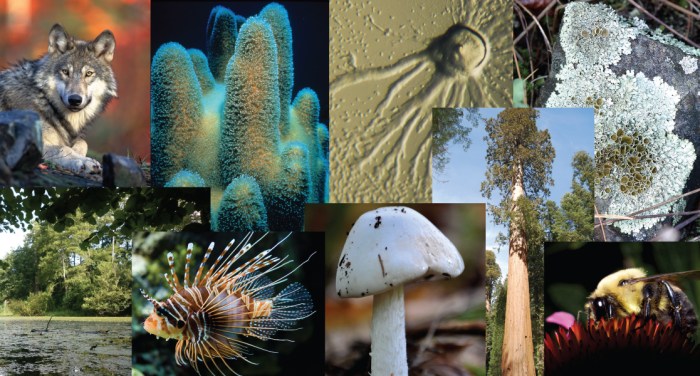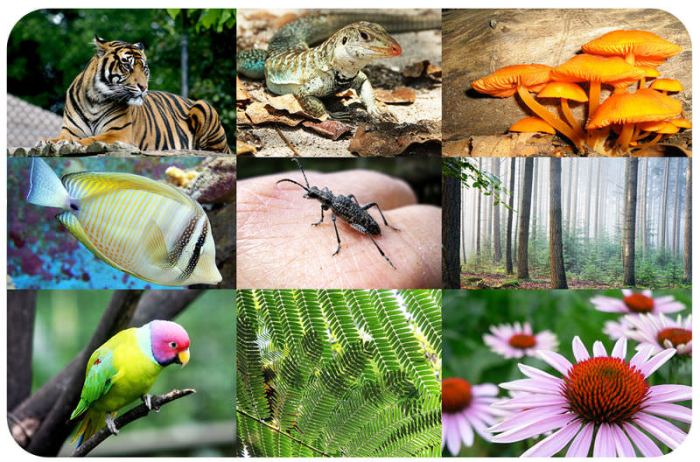Which of the following statements is true about biodiversity? This question delves into the multifaceted concept of biodiversity, encompassing its levels, threats, conservation strategies, economic value, and relationship with climate change. Biodiversity, the intricate tapestry of life on Earth, holds immense importance for the planet and future generations, necessitating its conservation and sustainable utilization.
Biodiversity encompasses genetic diversity within species, species diversity within ecosystems, and ecosystem diversity across landscapes. It underpins ecosystem functioning, providing essential services such as pollination, water purification, and carbon sequestration. However, biodiversity faces numerous threats, including habitat loss, pollution, climate change, and invasive species, which can disrupt ecosystem processes and diminish the resilience of natural systems.
1. Defining Biodiversity: Which Of The Following Statements Is True About Biodiversity

Biodiversity refers to the variety and abundance of life on Earth, encompassing all living organisms, their genetic diversity, and the ecosystems they inhabit. It is crucial for the functioning of ecosystems and provides numerous benefits to human well-being.
Biodiversity exists at three levels:
- Genetic diversity: Variation in genetic material within a species, allowing for adaptation and resilience.
- Species diversity: The number and variety of different species within an ecosystem.
- Ecosystem diversity: The variety of habitats and ecosystems, each with its unique assemblage of species and interactions.
Examples of biodiversity include:
- The vast array of plant and animal species in a tropical rainforest.
- The genetic diversity of a crop species that allows for resistance to pests and diseases.
- The interconnectedness of species in a coral reef ecosystem.
2. Threats to Biodiversity

Biodiversity faces numerous threats, including:
- Habitat loss and degradation: Deforestation, urbanization, and agricultural expansion.
- Pollution: Chemical contamination from industrial processes, agriculture, and transportation.
- Climate change: Rising temperatures, changes in precipitation patterns, and extreme weather events.
- Invasive species: Non-native species that outcompete native species for resources.
These threats impact biodiversity by:
- Reducing habitat availability and quality.
- Introducing toxins and pathogens.
- Altering species interactions and ecosystem dynamics.
Biodiversity loss has severe consequences for human well-being, including:
- Reduced food security and nutrition.
- Increased vulnerability to climate change and natural disasters.
- Loss of cultural and recreational values.
3. Conservation of Biodiversity
Conserving biodiversity is crucial for the planet and future generations. Conservation strategies include:
- Protected areas: Establishing national parks, wildlife refuges, and marine sanctuaries to safeguard habitats.
- Sustainable land use practices: Implementing agricultural and forestry techniques that minimize environmental impacts.
- Species recovery programs: Restoring endangered or threatened species populations.
Challenges in biodiversity conservation include:
- Balancing conservation with economic development.
- Addressing the root causes of biodiversity loss, such as poverty and inequality.
- Securing funding and resources for conservation efforts.
Opportunities for biodiversity conservation lie in:
- Collaboration between governments, organizations, and communities.
- Integrating biodiversity conservation into decision-making processes.
- Raising public awareness and promoting sustainable practices.
4. Economic and Social Value of Biodiversity
Biodiversity provides numerous economic benefits, including:
- Ecosystem services: Pollination, water purification, and carbon sequestration.
- Tourism: Wildlife viewing and ecotourism generate revenue.
- Agriculture: Genetic diversity provides resistance to pests and diseases, enhancing crop yields.
Biodiversity also holds social and cultural importance:
- Traditional knowledge: Indigenous communities rely on biodiversity for food, medicine, and cultural practices.
- Cultural and spiritual values: Many cultures have deep connections to specific species and ecosystems.
- Aesthetic and recreational value: People enjoy spending time in nature, appreciating its beauty and diversity.
5. Biodiversity and Climate Change

Biodiversity plays a crucial role in mitigating climate change:
- Carbon sequestration: Forests and oceans absorb carbon dioxide from the atmosphere.
- Climate regulation: Ecosystems help regulate temperature, precipitation, and wind patterns.
- Adaptation to climate change: Biodiversity provides resilience to species and ecosystems facing changing environmental conditions.
Climate change also poses threats to biodiversity:
- Habitat shifts: Species may need to migrate to new areas with suitable climates.
- Phenological changes: Changes in flowering and fruiting times can disrupt species interactions.
- Increased vulnerability to extreme events: Species may be less resilient to droughts, floods, and heatwaves.
Addressing the relationship between biodiversity and climate change requires:
- Integrating biodiversity conservation into climate change mitigation and adaptation strategies.
- Protecting and restoring habitats that provide carbon sinks and climate regulation services.
- Supporting species recovery and adaptation programs to enhance resilience to climate change.
User Queries
What is the importance of biodiversity?
Biodiversity provides essential ecosystem services, such as pollination, water purification, and climate regulation. It also supports food security, livelihoods, and cultural practices.
What are the major threats to biodiversity?
Habitat loss, pollution, climate change, and invasive species are among the primary threats to biodiversity, leading to species extinction and ecosystem degradation.
How can we conserve biodiversity?
Conservation strategies include establishing protected areas, implementing sustainable land use practices, and engaging in species recovery programs.
What is the relationship between biodiversity and climate change?
Biodiversity can mitigate climate change through carbon sequestration and climate regulation. However, climate change also poses threats to biodiversity, altering species distributions and disrupting ecosystems.